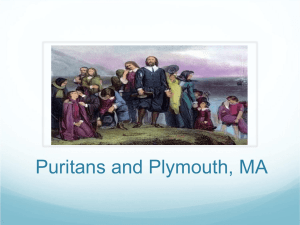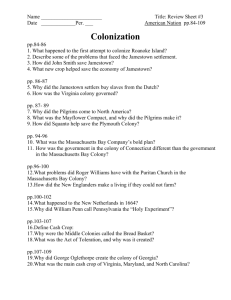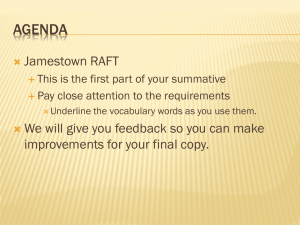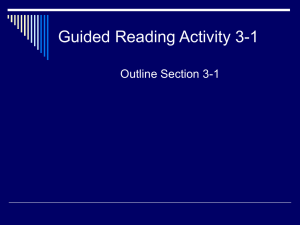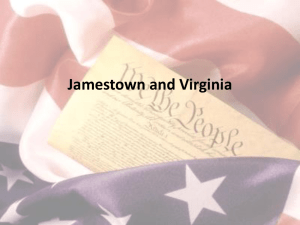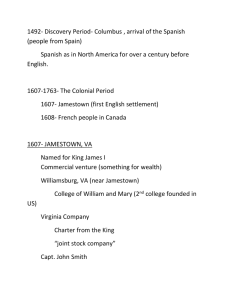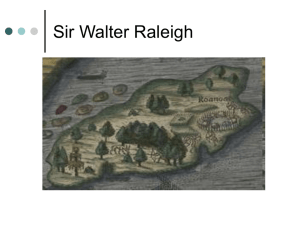Early English Settlements in North America 7
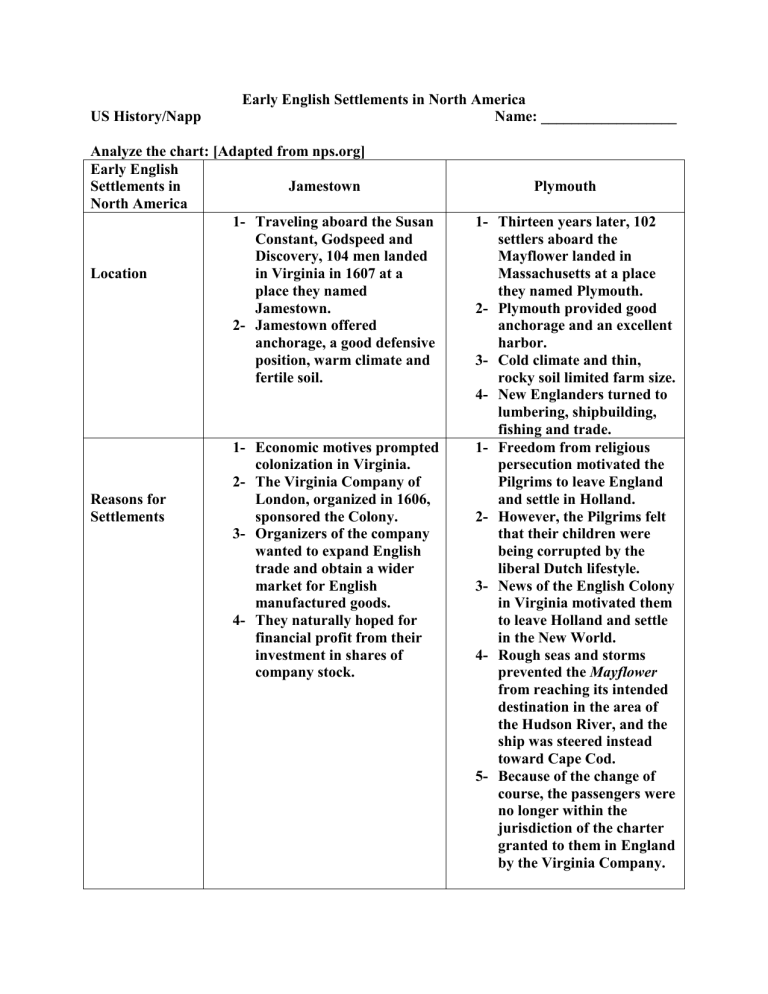
Early English Settlements in North America
US History/Napp Name: __________________
Analyze the chart: [Adapted from nps.org]
Early English
Settlements in
North America
Jamestown Plymouth
Location
Reasons for
Settlements
1Traveling aboard the Susan
Constant, Godspeed and
Discovery, 104 men landed in Virginia in 1607 at a place they named
Jamestown.
2Jamestown offered anchorage, a good defensive position, warm climate and fertile soil.
1Thirteen years later, 102 settlers aboard the
Mayflower landed in
Massachusetts at a place they named Plymouth.
2Plymouth provided good anchorage and an excellent harbor.
3Cold climate and thin, rocky soil limited farm size.
4New Englanders turned to lumbering, shipbuilding, fishing and trade.
1Freedom from religious persecution motivated the
Pilgrims to leave England and settle in Holland.
2However, the Pilgrims felt that their children were being corrupted by the liberal Dutch lifestyle.
3News of the English Colony in Virginia motivated them to leave Holland and settle in the New World.
4Rough seas and storms prevented the Mayflower from reaching its intended destination in the area of the Hudson River, and the ship was steered instead toward Cape Cod.
5Because of the change of course, the passengers were no longer within the jurisdiction of the charter granted to them in England by the Virginia Company.
1Economic motives prompted colonization in Virginia.
2The Virginia Company of
London, organized in 1606, sponsored the Colony.
3Organizers of the company wanted to expand English trade and obtain a wider market for English manufactured goods.
4They naturally hoped for financial profit from their investment in shares of company stock.
Early Setbacks
Government
1Inexperience, unwillingness to work, and the lack of wilderness survival skills led to disagreements and inaction at Jamestown.
2Poor Indian relations and disease compounded the
1problems.
In 1619, the first representative legislative assembly in the New World met at the Jamestown church.
1Cooperation and hard work were part of the
Pilgrim’s lifestyle.
2Nevertheless, they too were plagued with hunger, disease, and environmental hazards.
1Since New England was outside the jurisdiction of
Virginia’s government, the
Pilgrims established a selfgoverning agreement of their own, the “Mayflower
Compact.”
1Though more than half the
The Fate
1The Powhatan Indians stopped bartering for food.
2Hunting became highly dangerous, as Powhatan
Indians also killed
Englishmen.
3Long reliant on the Indians, the colony found itself with far too little food for the winter.
4As the food stocks ran out, the settlers ate the colony’s animals – horses, dogs, and cats – and then turned to eating rats, mice, and shoe leather.
5In their desperation, some practiced cannibalism.
6Winter of 1609- 10: the
Starving Time. original settlers died during that grueling first winter, the survivors were able to secure peace treaties with neighboring Native
American tribes and build a largely self-sufficient economy within five years.
Identify ten differences between the settlements at Jamestown and Plymouth:
1-
2-
3-
4-
5-
6-
7-
8-
9-
The Article: Starving Settlers in Jamestown Colony Resorted to Cannibalism;
Smithsonian Magazine, Joseph Stromberg, May 1, 2013
The harsh winter of 1609 in Virginia’s Jamestown Colony forced residents to do the unthinkable. A recent excavation at the historic site discovered the carcasses of dogs, cats and horses consumed during the season commonly called the “Starving Time.” But a few other newly discovered bones in particular, though, tell a far more gruesome story: the dismemberment and cannibalization of a 14-year-old English girl.
“The chops to the forehead are very tentative, very incomplete,” says Douglas Owsley, the
Smithsonian forensic anthropologist who analyzed the bones after they were found by archaeologists from Preservation Virginia. “Then, the body was turned over, and there were four strikes to the back of the head, one of which was the strongest and split the skull in half. A penetrating wound was then made to the left temple, probably by a single-sided knife, which was used to pry open the head and remove the brain.”
…It’s long been speculated that the harsh conditions faced by the colonists of Jamestown might have made them desperate enough to eat other humans – and perhaps even commit murder to do so. The colony was founded in 1607 by 104 settlers aboard three ships, the
Susan Constant, Discovery and Godspeed, but only 38 survived the first nine months of life in Jamestown, with most succumbing to starvation and disease (some researchers speculate that drinking water poisoned by arsenic and human waste also played a role). Because of difficulties in growing crops – they arrived in the midst of one of the worst regional droughts in centuries and many settlers were unused to hard agricultural labor – the survivors remained dependent on supplies brought by subsequent missions, as well as trade with Native Americans.
By the winter of 1609, extreme drought, hostile relations with members of the local
Powhatan Confederacy and the fact that a supply ship was lost at sea put the colonists in a truly desperate position. Sixteen years later, in 1625, George Percy, who had been president of Jamestown during the Starving Time, wrote a letter describing the colonists’ diet during that terrible winter. “Haveinge fedd upon our horses and other beastes as longe as they Lasted, we weare gladd to make shifte with vermin as doggs Catts, Ratts and myce…as to eate Bootes shoes or any other leather,” he wrote. “And now famin beginneinge to Looke gastely and pale in every face, thatt notheinge was Spared to mainteyne Lyfe and to doe those things which seame incredible, as to digge upp deade corpes outt of graves and to eate them. And some have Licked upp the Bloode which hathe fallen from their weake fellowes.”
Despite this and other textual references to cannibalism, though, there had never been hard physical evidence that it had occurred—until now.
…Owsley speculates that this particular Jamestown body belonged to a child who likely arrived in the colony during 1609 on one of the resupply ships. She was either a maidservant or the child of a gentleman, and due to the high-protein diet indicated by his team’s isotope analysis of her bones, he suspects the latter. The identity of whoever
consumed her is entirely unknown, and Owsley guesses there might have been multiple cannibals involved, because the cut marks on her shin indicate a more skilled butcher than whoever dismembered her head.
It appears that her brain, tongue, cheeks and leg muscles were eaten, with the brain likely eaten first, because it decomposes so quickly after death. There’s no evidence of murder, and Owsley suspects that this was a case in which hungry colonists simply ate the one remaining food available to them, despite cultural taboos. “I don’t think that they killed her, by any stretch,” he says. “It's just that they were so desperate, and so hard-pressed, that out of necessity this is what they resorted to.”
Questions:
1What does the article reveal about life in Jamestown?
______________________________________________________________________________
______________________________________________________________________________
______________________________________________________________________________
______________________________________________________________________________
______________________________________________________________________________
______________________________________________________________________________
______________________________________________________________________________
2Why are forensic anthropologists essential for studying certain aspects of the path?
And for what aspects of the past are forensic anthropologists particularly important?
______________________________________________________________________________
______________________________________________________________________________
______________________________________________________________________________
______________________________________________________________________________
______________________________________________________________________________
______________________________________________________________________________
______________________________________________________________________________
3Could any actions on the part of settlers have prevented this tragedy (think particularly about decisions made by settlers before the tragedy)?
______________________________________________________________________________
______________________________________________________________________________
______________________________________________________________________________
______________________________________________________________________________
______________________________________________________________________________
______________________________________________________________________________
______________________________________________________________________________
4What conditions or factors in particular led to this tragedy?
______________________________________________________________________________
______________________________________________________________________________
______________________________________________________________________________
Primary Source: The Mayflower Compact: 1620
Agreement Between the Settlers at New Plymouth: 1620
IN THE NAME OF GOD, AMEN. We, whose names are underwritten, the Loyal Subjects of our dread Sovereign Lord King James, by the Grace of God, of Great Britain, France, and Ireland, King, Defender of the Faith, &c. Having undertaken for the Glory of God, and
Advancement of the Christian Faith, and the Honour of our King and Country, a Voyage to plant the first Colony in the northern Parts of Virginia; Do by these Presents, solemnly and mutually, in the Presence of God and one another, covenant and combine ourselves together into a civil Body Politick, for our better Ordering and Preservation, and
Furtherance of the Ends aforesaid: And by Virtue hereof do enact, constitute, and frame, such just and equal Laws, Ordinances, Acts, Constitutions, and Officers, from time to time, as shall be thought most meet and convenient for the general Good of the Colony; unto which we promise all due Submission and Obedience. IN WITNESS whereof we have hereunto subscribed our names at Cape-Cod the eleventh of November, in the Reign of our
Sovereign Lord King James, of England, France, and Ireland, the eighteenth, and of
Scotland the fifty-fourth, Anno Domini; 1620.
Questions:
1In your own words, state what the settlers at New Plymouth were establishing?
______________________________________________________________________________
______________________________________________________________________________
______________________________________________________________________________
______________________________________________________________________________
______________________________________________________________________________
2Why were the settlers at New Plymouth establishing this?
______________________________________________________________________________
______________________________________________________________________________
______________________________________________________________________________
______________________________________________________________________________
______________________________________________________________________________
3Why is the Mayflower Compact a significant advancement in the evolution of representative government?
______________________________________________________________________________
______________________________________________________________________________
______________________________________________________________________________
______________________________________________________________________________
______________________________________________________________________________
4How does representative government differ from other forms of government?
______________________________________________________________________________
______________________________________________________________________________
1.
The Magna Carta and the English
Bill of Rights were significant influences on United States constitutional development because
(1) they provided suffrage for all men and women
(2) they placed limits on the powers of the government
(3) called for the abolition of slavery
(4) supported the development of federalism
2.
In colonial America, the House of
Burgesses, the Mayflower Compact, and town hall meetings were all developments that led to the
(1) regulation of trade with Native
American Indians
(2) protection of the rights of women
(3) elimination of the power of the upper classes
(4) creation of representative government
3.
The Mayflower Compact is considered an important step in the development of American democracy because it
(1) established the principle of separation of church and state
(2) provided a basis for selfgovernment in the Plymouth Colony
(3) defined relations with local Native
American Indians
(4) outlawed slavery in the
Massachusetts Bay Colony
4.
The Mayflower Compact and the
Virginia House of Burgesses are most closely associated with
(1) abuses by absolute monarchs
(2) religious toleration
(3) steps toward colonial selfgovernment
(4) universal suffrage
5. Which heading best completes the partial outline below?
I. _________________________________
A. Mayflower Compact
B. House of Burgesses
C. New England town meetings
(1) Attempts to Overthrow British Rule
(2) Development of Self-Government in the
American Colonies
(3) Establishment of British Parliamentary
Control Over the Colonies
(4) Social Reform Movements in the
American Colonies
6. Which heading best completes the partial outline below?
I. __________________________
A. Magna Carta
B. House of Burgesses
C. Town meetings
D. John Locke
(1) Ideas of Social Darwinism
(2) Basis of British Mercantilism
(3) Contributions to American Literature
(4) Influences on United States
Constitutional Government
7. The Mayflower Compact, New England town meetings, and the Virginia House of
Burgesses are examples of
(1) early colonial efforts in self-government
(2) colonial protests against British taxation
(3) governments imposed by Parliament
(4) attempts to limit democracy

